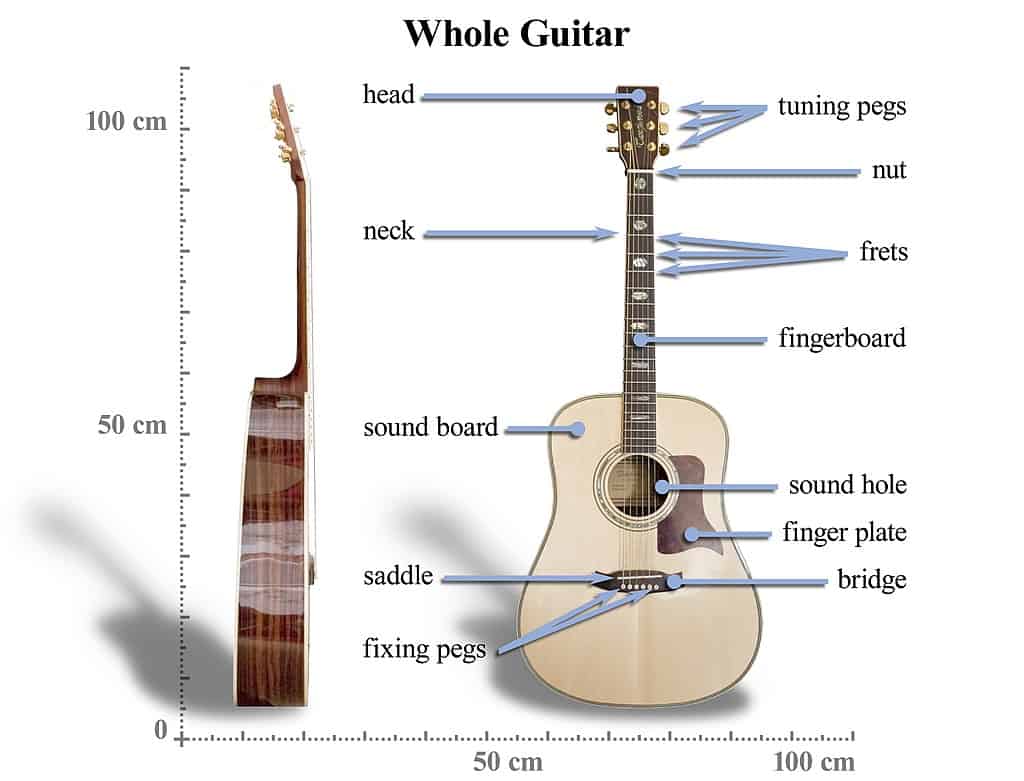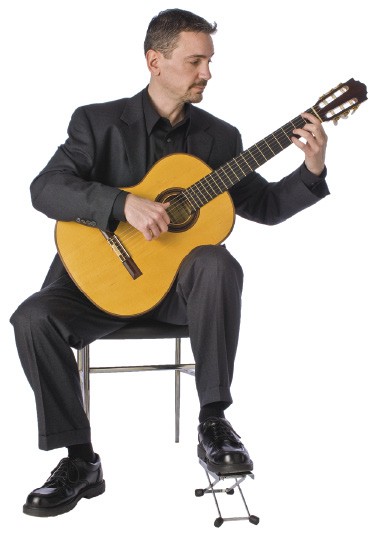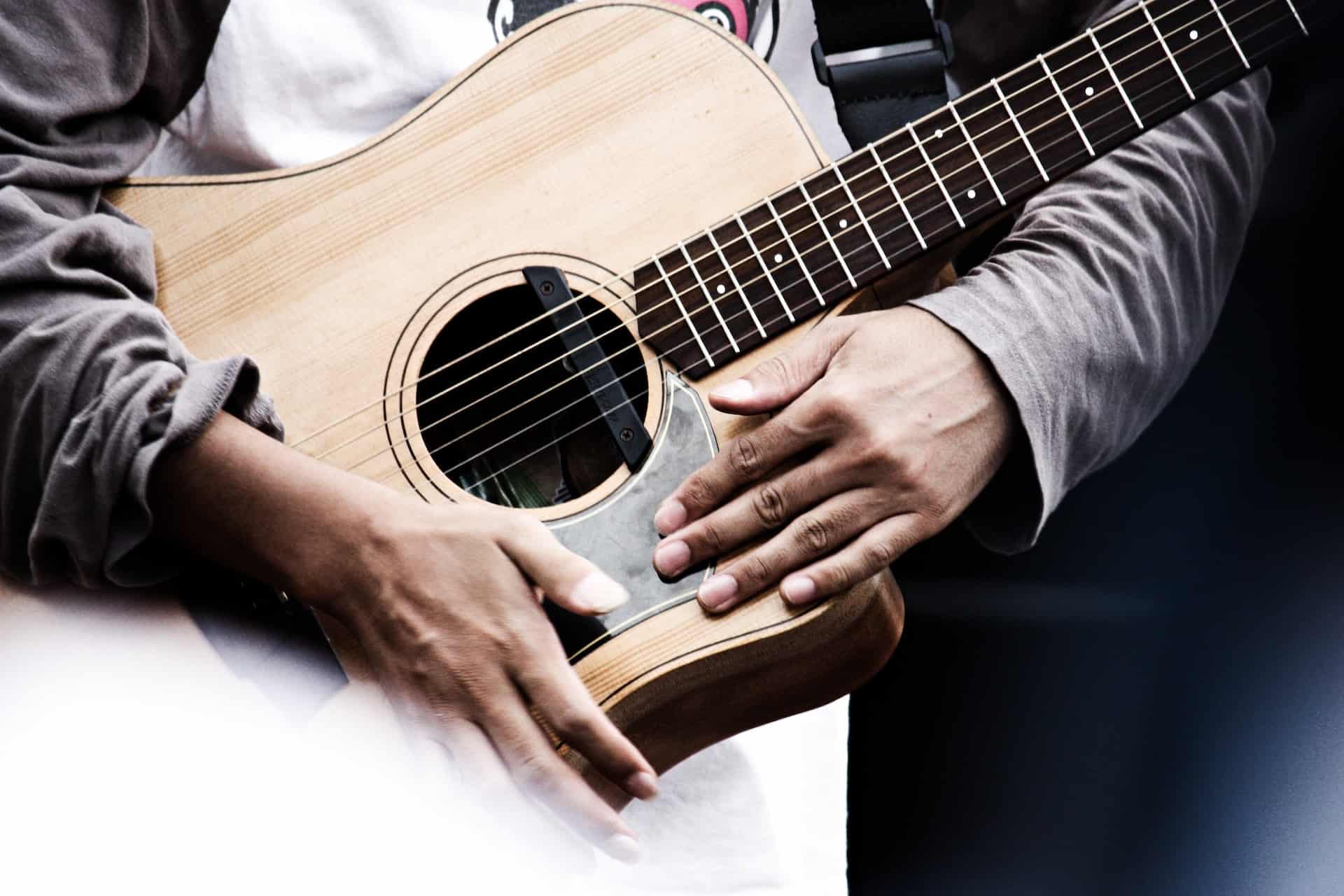Perhaps you found in the garage the old guitar that your dad or grandpa used to play in those long summer days. Maybe, you saw an exciting performance, and you’re considering buying an acoustic guitar for yourself. In this article, you will find the basic stuff you need to know if you’re asking how to learn to play an acoustic guitar!
Can anyone play acoustic guitar?
Although it may seem intimidating to some, an acoustic guitar is one of those instruments that is very friendly to learn and that allows beginners to build a sense of confidence and pride early on! Your overall size and the size of your hands matter little since there are many different sizes of guitars to choose from. You don’t need to know a lot about music to start playing since guitar can also be a fairly good introductory instrument to the nuances of music. All you need is your guitar and the right mindset to start!
Pros and Cons of playing an acoustic guitar
Before talking about the pros and cons of starting to play acoustic guitar, we need to consider that, as with any instrument, achieving good results takes considerable time and effort. Having said this, let’s evaluate some pros and cons:
- Pro: There is a wide price range for acoustic guitars, meaning that there is a guitar for every budget.
- Con: Choosing the right guitar for you at the beginning can be a hassle.
- Pro: You will have endless hours of fun playing your favorite songs and, why not, creating your own.
- Con: The sound of an acoustic guitar is not as modifiable as an electric guitar’s sound due to not being able to connect to a pedal or amplifier (unless you have an electro-acoustic model). So, if you want a different sound, you will have to get new strings or a new guitar.
- Pro: You don’t need electrical power to play an acoustic guitar.
- Con: If you want to be heard by a large or distant crowd, you will probably need a microphone or an electric guitar.
- Pro: Unlike fretless instruments, as long as you keep your guitar tuned, fingering with your fretting hand is very straightforward.
- Con: Every musical instrument should be treated delicately, but since guitars are hollow-bodied, they are especially delicate.
Know your instrument

What makes the acoustic guitar acoustic is that its sound comes from the resonance box formed by its hollow body. Inside this resonance box, the vibrations of the strings get amplified and projected to the outside every time we play them. The tone produced by the strings can be modified by pressing them against the frets, which are the metal bars that go across the neck of the guitar. The strings go from the bridge, atop the soundhole, all along the neck up to the headstock.
Acoustic guitars usually have round bodies, similar to an 8. Some guitars will have a shoulder cut off to facilitate the access to the higher frets. Acoustic guitars are usually made out of wood, the type of wood can affect the quality and properties of its sound.
Replacing your strings
One of the most important and satisfying parts of playing an acoustic guitar is being able to learn its basic maintenance aspects, such as replacing a string. This can help you develop a sense of autonomy and a better relationship with your instrument and music altogether.
You can get string packs from your music store. These vary in gauges. A rule of thumb to go about string gauge is that the thicker they are, the stronger the strumming or picking must be, and the sound will be crisper as well.
As the strings in a guitar give different notes, you will notice as well that the strings are different from each other. Most acoustic guitars have nylon strings for the treble strings and wound metal strings for the bass strings. Strings with the lowest sounds will be thicker, and the ones that produce higher pitches will be thinner. If you are right-handed, your thickest wound metal string (low E string) should be to the left when the guitar is facing you, headstock up. Conversely, your thinnest nylon string (high E string) will be in the rightmost position.
There are two places where strings are attached to a guitar: on the headstock and on the bridge. More often than not, in the headstock, strings will loop around a hole in a piece that is connected to each tuning peg. In the bridge, the strings might be held by a snapping piece or by inserting it in a hole and making a knot.
Learning to tune
Tuning is another essential part of the guitar that helps to develop a good ear and improves our playing quality. There are few and notable exceptions in which a guitar that is out of tune will sound good. The rest of the time, a string or strings out of tune can spoil a good performance.
There are a lot of tunings for the guitar. However, the standard tuning is, from lowest to highest, as follows:
E2 A2 D3 G3 B3 E4
To achieve this, adjust the tuning pegs of each string, one string at a time, and pulse the string until you reach the desired note. You can help yourself to tune your guitar with a diapason, another instrument already in tune, a digital tuner or a tuning app.
The correct posture
Sit in a stool or high chair with your back straight and relaxed arms. Have a small stool or cross your legs so that your left thigh is slightly higher than your right thigh. Allow the body of the guitar to rest between your legs, with its back to your chest. The guitar’s neck must be pointing upwards, roughly at a 45-degree angle. The headstock should be approximately at the same level as your shoulder.

Your strumming arm must rest on top of the body in a comfortable position that allows reaching the strings without bending your wrist. Your fretting hand must grab the neck in a way that allows the thumb to rest in its back, and the rest of the fingers can press down the strings without curving, flattening the fingers or bending the wrist too much.
Your first notes
One of the first things we need to develop when learning any instrument is note awareness. Knowing where every note is on the guitar is key to being able to play anything on it. One of the most important notes to locate is middle C, also known as C3. You will find it by pressing the A string behind the 3rd fret and pulsing the string. We can use it as a starting point to learn the scale of C.
- Press the A string in the 3rd fret for C.
- Play the D string open for D.
- Press the D string in the 2nd fret for E.
- Press the D string in the 3rd fret for F.
- Play the G string open for G.
- Press the G string in the 2nd fret for A.
- Play the B string open for B.
- Press the B string in the 1st fret for C in a higher octave!
The basic chords
One of the main features of the guitar is the accompaniment it can provide by using chords. Chords are several tones, usually three or four, layered and that have a harmonic relationship between each other. Chords set the ground for melodies and, sometimes, songs can be recognizable by its chords only. Below, you will find how to perform the 5 basic figures for major chords.
These figures suffer slight modifications each to produce every chord and variation that exists. To learn more about chords, please read our article on how to learn chords.
Learning tabs
Music is rather hard to learn by ear only, and explaining note by note, chord by chord with a verbal description can get wordy and tiring very quickly. This has led to the appearance of musical languages. Specifically for the guitar, we have tablature notation, commonly known as tabs.

Tabs indicate the string that must be played, which fret must be pressed and the rough sequence in which fret and string combine to form a melody.
Learn from every style, find your own
From Baroque music to Folk and Blues, from Flamenco to Bossanova, you will find many different guitar sounds and styles across time and space. Listen to a lot of music, look up the styles, and see what techniques you can learn from each so that you can develop your own tastes and sound.
Remember to take some time every day you can listen to music and practice with your guitar, and you’ll soon be hearing good results. Happy playing!








